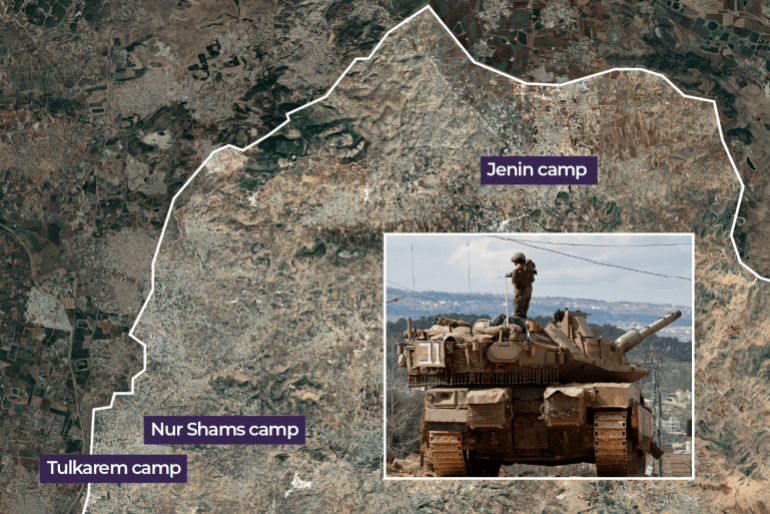Israel is applying many of the tactics used in its war on Gaza to seize and control territory across the occupied West Bank during its Operation Iron Wall campaign, a new report says.
Israel launched the operation in January. Defending what the United Nations agency for Palestinian refugees (UNRWA) termed “by far the longest and most destructive operation in the occupied West Bank since the second intifada in the 2000s”, the Israeli military claimed its intention was to preserve its “freedom of action” within the Palestinian territory as it continued to rip up roads and destroy buildings, infrastructure, and water and electricity lines.
The report by the British research group Forensic Architecture suggested Israel has imposed what researchers call a system of “spatial control”, essentially a series of mechanisms that allow it to deploy military units across Palestinian territory at will.
The report focused on Israeli action in the refugee camps of Jenin and Far’a in the northern West Bank and Nur Shams and Tulkarem in the northwestern West Bank. Researchers interviewed and analysed witness statements, satellite imagery and hundreds of videos to demonstrate a systematic plan of coordinated Israeli action intended to impose a network of military control in refugee camps across the West Bank similar to that imposed upon Gaza.

In the process, existing roads have been widened while homes, private gardens and adjacent properties have been demolished to allow for the rapid deployment of Israeli military vehicles.
“This network of military routes is clearly visible in the Jenin refugee camp and evidence indicates that the same tactic is, at the time of publication, being repeated in the Nur Shams and Tulkarm refugee camps,” the report’s authors noted.
Israeli ministers have previously stated that they planned to use the same methods in the West Bank that have destroyed the Gaza Strip, leading to more than 54,000 Palestinians killed and the majority of buildings damaged or destroyed.
In January, Defence Minister Israel Katz said Israel would apply the “lesson” of “repeated raids in Gaza” to the Jenin refugee camp. The following month, Finance Minister Bezalel Smotrich, who has control over much of the administration of the West Bank, boasted that “Tulkarem and Jenin will look like Jabalia and Shujayea. Nablus and Ramallah will resemble Rafah and Khan Younis,” comparing refugee camps in the West Bank to areas in Gaza that have been devastated by Israeli bombing and ground offensives.
“They will also be turned into uninhabitable ruins, and their residents will be forced to migrate and seek a new life in other countries,” Smotrich said.
Hamze Attar, a Luxembourg-based defence analyst, told Al Jazeera these tactics are not new in Palestinian territory, having first been deployed by the British during their mandate over historic Palestine, which preceded Israel’s foundation in 1948.
“It’s part of the “counterinsurgency” strategy,” he said. “Bigger roads [mean] easy access to forces – bigger roads, less congested battle management; bigger roads, less ability for fighters to escape from house to house.”
Displacing the displaced
About 75,000 Palestinians live in the Jenin, Nur Shams, Far’a and Tulkarem refugee camps. They were either displaced themselves or descended from those displaced during the Nakba (which means “catastrophe”) when roughly 750,000 Palestinians were forced from their homes by Zionist forces from 1947 to 1949 as part of the creation of Israel.
Now, at least 40,000 of those living in the West Bank refugee camps have been displaced as a result of Operation Iron Wall, according to the United Nations.
As in Gaza, many of these people were forced from their homes on orders from the Israeli military, which researchers said have been “weaponised” against the local population.
Once an area had been cleared of its buildings and roads, it becomes a kill zone and the Israeli military is free to reshape and build whatever it likes without interference from residents, the report said.
“Such engineered mass displacement has allowed the Israeli military to reshape these built environments unobstructed,” the report noted, adding that when Palestinian residents did try to return to their homes after Israeli military action, they were often obstructed by the continued presence of troops.
Destroying infrastructure
Forensic Architecture researchers said Israeli attacks on medical facilities in Gaza have also spilled over into the West Bank.
“Israeli attacks on medical infrastructure in the West Bank have included placing hospitals under siege, obstructing ambulance access to areas with injured civilians, targeting medical personnel, and using at least one medical facility as a detention and interrogation centre,” the report said.
During Israel’s initial attacks on the Jenin refugee camp on January 21, multiple hospitals were surrounded by the Israeli military, including Jenin Government Hospital, al-Amal Hospital and al-Razi Hospital, researchers noted.
The following day, civilians and hospital staff reported that the main road leading to Jenin Government Hospital was destroyed by Israeli military bulldozers and access to the hospital was blocked by newly constructed berms, or land barriers,
On February 4, reports from Jenin said the Israeli military was obstructing ambulances carrying injured people from reaching the hospital.
Also carrying unmistakable echoes of Gaza was an UNRWA report in early February saying the Israeli military had forcibly co-opted one of the health centres at the UNRWA-run Arroub camp near Jerusalem as an interrogation and detention site.
The attacks on healthcare facilities were part of a wider campaign to damage civilian infrastructure in the West Bank, the Forensic Architecture report said, using armoured bulldozers, controlled demolitions and air attacks.
Researchers said they verified more than 200 examples of Israeli soldiers deliberately destroying buildings and street networks in all four of the refugee camps with armoured bulldozers reducing civilian roads to barely passable piles of exposed earth and rubble.
Civilian property, including parked vehicles, food carts and agricultural buildings, such as greenhouses, were also destroyed during Israeli military operations, they said.